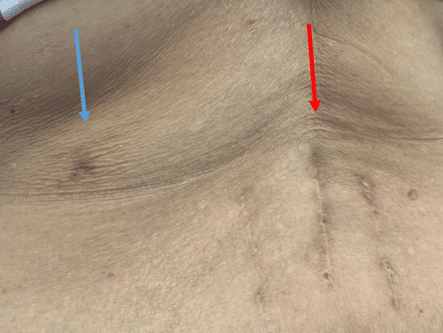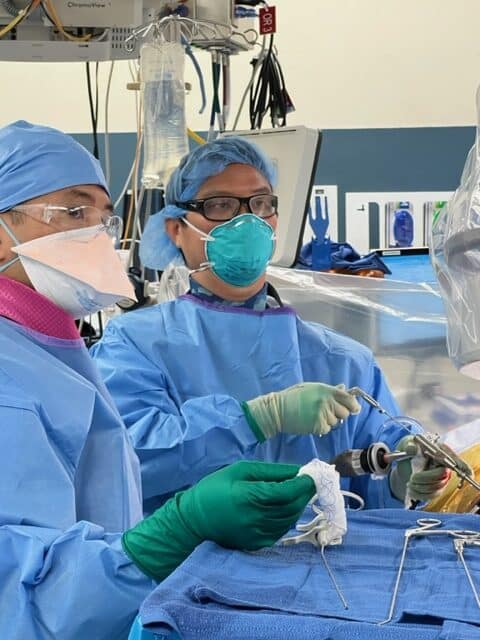
Our ultimate goal as spine surgeons is to not only treat problems affecting the spine, but to do so in a way that minimizes injury to the surrounding structures so that patients can heal faster compared to more traditional, more invasive surgical approaches. Minimally invasive and ultra-minimally invasive (endoscopic) surgical techniques allow us to do just that.
Our team of surgeons have traveled around the world to train with some of the leaders in minimally invasive and endoscopic spine surgery. Their hope is to utilize the most advanced, least invasive surgical options available in order to maximize the chances for a successful patient outcome.
What is Minimally Invasive Spine Surgery?
Minimally invasive spine surgery encompasses modern techniques and technologies that allow surgeons to target problem areas in the spine in a way that minimizes trauma to the body. Minimally invasive spine surgery typically involves the use of specialized instruments, such as retractors and microinstruments. These tools and techniques allow surgeons to gently spread or dilate muscles in your neck/back rather than cutting through them. This allows for smaller incisions, less damage to the muscles in your neck/back, and less postoperative pain.
What is Ultra-Minimally Invasive (Endoscopic) Spine Surgery?
Ultra-minimally invasive spine surgery, also known as endoscopic spine surgery, involves making a quarter-inch incision and placing a tiny camera and specialized endoscopic instruments through that tiny incision to accurately target different structures in the spine.

Endoscopic incision (blue arrow) compared to traditional “open” surgical incision (red arrow).
The goals of endoscopic spine surgery are usually the same as traditional, open surgery– to clean out disc herniations, bone spurs, and overgrown ligaments that may be pinching the nerves in your neck/back. However, with the use of a tiny camera and other specialized endoscopic instruments, we can access specific problem areas in the neck/back while minimizing “collateral damage” to the surrounding muscles and soft tissue.
By providing patients with an easier postop recovery and better outcomes compared to more traditional surgical approaches, spine endoscopy has completely transformed the field of spine surgery.
What conditions can be treated with Minimally Invasive & Endoscopic Spine Surgery?
We use minimally invasive spine surgery techniques to treat a variety of conditions:
- Decompressing pinched nerves in the back (lumbar stenosis, lumbar radiculopathy, “sciatica”)
- Decompressing pinched nerves in the neck (cervical radiculopathy, cervical stenosis, myelopathy)
- Spine fusion (for “slipped discs”, aka spondylolisthesis)
- Correction of spine deformity (such as scoliosis and kyphosis)
- Treating tumors and infections in the spine
- Stabilizing spinal fractures
What are the benefits of Minimally Invasive & Endoscopic Spine Surgery?
When compared to more traditional, “open” spine surgery, minimally invasive/endoscopic surgery can result in:
- Smaller, more cosmetic incisions
- Less blood loss
- Lower complication rates
- Less postoperative pain
- Quicker recovery
- Shorter hospital stay
- Faster return to work
- Less reliance on pain medications
- Lower risk of infection
In some cases, minimally invasive or endoscopic spine surgery can be an alternative to spine fusion.

Dr. Lance Mitsunaga using a small camera (aka endoscope) and specialized instruments through a tiny incision to remove the pressure off pinched nerves in a patient’s low back.
Who is a candidate for Minimally Invasive & Endoscopic Spine Surgery?
Most spine conditions can be treated using endoscopic or minimally invasive techniques. Often, if you are a candidate for neck or back surgery, you are a candidate for minimally invasive techniques. Occasionally, patients who may not be a candidate for traditional, “open” spine surgery may be a candidate for minimally invasive spine surgery. With that said, our surgeons customize each procedure to the individual patient and their unique needs.
For pinched nerves, endoscopic or minimally invasive surgery is often our surgeons’ first choice to remove the pressure off the nerves.
Our surgeons try to avoid spinal fusion if at all possible, but, in some cases, it is necessary. Spinal fusion can sound scary and intimidating but the modern techniques that are available today are a lot better than they were in the past. Often, our surgeons can utilize minimally invasive techniques to avoid making large incisions in the neck/back. This helps to minimize disruption of the stabilizing muscles in the neck/back. Instead, our surgeons may insert special retractors and tubes with lights and cameras at the end of them down to the spine. Special instruments can then be inserted through these retractors to perform spine fusion with smaller incisions and minimally invasive techniques.
Minimally Invasive & Endoscopic Spine Surgery in Honolulu, HI
While avoiding surgery is our primary goal, if it is necessary, our team of surgeons believe in offering you the least invasive surgical plan that is customized to your specific problem. We are pleased to be able to bring the most state-of-the-art, minimally invasive surgical options available in the field of spine surgery to Hawaii.
If you would like to schedule a consultation with one of our surgeons, please call our office at (808) 691-6511.
